Asaf Peres
Sonic Functions: The Producer's Alternative to Harmonic Functions in Modern Music
Most musicians who engage in music theory view harmonic functions as the backbone of western tonal music. And rightfully so—Nearly every widely-accepted analytical method treats the tonic–predominant–dominant–tonic cycle as the primary driver of musical drama in tonal music.
This is so ingrained in us that we tend to immediately assign a function to every chord. If we see/hear a I chord we call it the tonic, which implies stability. A V chord is automatically labeled as the dominant, which implies tension.
But what happens when these chords don’t perform the functions they are “supposed” to perform?
Let me give you an example: In Nicki Minaj’s “The Night is Still Young” there’s a four-chord loop that persists through the entire song:
IV–vi–V–ii, or A–C#m–B–F#m in the key of E major.
A chord loop generates some level of anticipation and tension just by being repetitive, but the V chord in this case doesn’t generate more tonal gravity than the other three chords. If V was a true dominant chord, we would hear a tendency for it to resolve to I, and following it with a ii instead would, at best, feel like a ‘deceptive’ move.
But I doubt anyone hears that tendency. In fact, if any chord in this loop generates more tension than the others it’s the ii chord, by virtue of being the last chord in the loop. But, of course, this is unrelated to tonal functionality.
The lack of tonal gravity is probably clearest in the second half of the bridge (2:45-3:00). The same chord loop continues, but the tension is generated by a sonic buildup: a combination of an intensifying drum pattern, a gradual brightening of the instrumental using a low-pass filter sweep, and the addition of more vocal lines and extension of their range.
Listen below:
This buildup has little to do with tonal gravity and a LOT to do with sonic gestures.
Also, note that when the tension is released (3:00) it's not due to the chord change from ii to IV, but thanks to the return of the regular drum beat and the vocal hook, as well as the beefing up of the low end and other key portions of the frequency spectrum.
So despite this song being tonal, in the sense that it uses a major key and diatonic triads as traditional tonal pieces, It's clear that the "functionality" here is sonic, not tonal.
SONIC FUNCTIONS
I came up with the term “sonic functions” a few years ago as I was working on my Ph.D. dissertation. I was quite amazed that I couldn’t find any reference to this term online and in academic journals.
After digging into a mass of pop songs, it became so obvious to me that sound production had assumed the same role that was once almost the exclusive domain of tonal functions, that it was very surprising to me that no one thought to slap this label on the phenomenon.
What are Sonic Functions?
Sonic functions are the producer's equivalent of harmonic functions. Like harmonic functions, sonic functions represent stages in tension and release cycles that drive a song's energy and musical drama.
However, there are two key differences:
- They rely on changes in the sonic density, intensity, and/or energy rather than dissonant/consonant pitch relationships.
- They do not have a parallel function to the tonal system's closing tonic.
Otherwise, sonic functions behave like tonal functions, in the sense that they govern the tension/release cycles in songs and can be expressed on multiple structural levels.
There are three primary sonic functions:
- SETUP
- BUILDUP
- CLIMAX
The most straightforward way to think about them is on the section-to-section level. A "normal" sonic progression would look something like this:

Of course, there are variations and the above image doesn't represent the sonic progression of every pop song.
There are also more sections, like the bridge, which normally functions as a sonic buildup, and the postchorus, which is usually a climax.
But before I get into all of these different situations and sections, I want to define the sonic functions a bit more and explain how they work.
The Makeup of Sonic Functions
Two of the three main sonic functions--the setup and climax--are rather self-explanatory. The setup constitutes a baseline of sonic energy, while the climax is a peak of sonic energy.
The buildup is a bit more complicated (and interesting, in my opinion). While the setup and climax are defined by their relative sonic energy, the buildup is defined by an increase of tension that causes the listener to anticipate the arrival of a climax. This tension buildup may or may not correlate with an increase in sonic energy.
More precisely, the most common ways to achieve a buildup of tension are:
- Adding elements to the sonic texture.
- Removing key elements from the sonic texture.
- Gradual gestures.
You may have noticed that the first to items in this list seem contradictory. However, the unifying factor is that all of the above techniques generate motion away from the baseline sonic energy and toward the climax.
The first technique--adding sonic elements--amps up the energy without yet reaching a climax, mentally moving the listener in the direction of the climax and causing them to anticipate its arrival.
Listen, for example, to the prechorus (0:31) in Charlie Puth's "Boy". Following a very thin texture in the verse, Puth adds backup vocals and more body to the synth.
This lets the listener feel the sonic progression, creating anticipation for the climax, which arrives at the chorus (0:41) with the introduction of a sonically dominant bass line.
The second technique--removing key elements--has the effect of creating a sonic void. It is even more effective at amping up the tension than adding elements because it creates a sonic void, making the listener crave for the return of those key elements.
A great example of this is Emily Warren's recent collab with the Chainsmokers, "Side Effects". The most dominant sonic element in the verse (outside of the vocals) is the bass, which makes its removal in the prechorus (0:22) jarring, almost like having an imaginary rug pulled from beneath our feet.
The tension generated by the removal of the bass is designed to draw you in and make you listen more closely. As a listener, in part because you are probably familiar with the genre's idioms, you not only know that the bass will return, but you know it will return in combination with other elements to form a climax, and you are likely to listen in anticipation of this arrival.
Perhaps the most effective method of generating tension, though, is the third technique--gradual gestures--most of these are also known as risers. They are fundamental to EDM buildups and are some of the most important imports from EDM to pop.
These gestures include filter sweeps, reverse reverbs, gradually pitching up various elements, intensifying the drums, and any other elements that creates the sonic illusion of upwards motion.
When they form an EDM-type buildup, these gradual gestures are often drawn out and added one-by-one to intensify the buildup, like in Calvin Harris and Rihanna's "We Found Love" (1:44-2:00):
However, the most common use for gradual gestures in today's pop, and related genres, is to amp up the tension at the very end of a section. This is normally done in combination with removing key elements, and is not restricted to EDM-style pop songs.
Notice, for example, how just prior to the arrival of the chorus in Bebe Rexha's "I'm a Mess" (starting ~0:42), the low end is abruptly filtered out, the low knocks are replaced with high claps at double the speed, and a background vocal suddenly takes over and is gradually pitched up, drawing our attention "upwards" to make the following "drop" more effective.
What About Cadences?
It's important to remember that although a climax constitutes the release of tension generated by the buildup, it is not the same as a cadence.
A cadence is widely understood as a musical stopping or resting point, and the climax does not fit that criteria. A climactic section by its definition is very intense and does not let up until the music moves on to the next section, which usually kicks off another setup or buildup.
In fact, real cadences are extremely rare in modern pop. There are occasional melodic cadences, but pop songs generally want the listener to physically move to the music, and resting points can sabotage this goal.
Is it possible to generate a cadence in pop? Sure, but unlike building up tension or arriving at a climax, which only requires some elements of the musical texture to participate, a real cadence requires all elements to 'agree'.
If the harmony and melody arrive at the tonic, but it's on a weak metric beat, or the sonic texture retains a high level of energy, it's not going to sound like a cadence.
If the sonic energy relaxes but the pitch material generates functional tension, it's still not going to sound like a cadence.
Everything has to work together to create a cadence, and this generally doesn't happen in today's pop, except in some rare cases like Tove Lo's "Timebomb", which I mentioned in a previous post.
It should be noted, however, that cadences are possible, and more importantly, that although setup, buildup, and peak are the main and most important sonic functions in the genre, they are not the only possible ones.
The "Timebomb" example suggests that there can be a resting function, as long as it works along with the other musical aspects.
The outro of "The Night is Still Young", which I mentioned at the beginning of this post, features a gradual filtering of the music, which could be described as a diffusion sonic function.
The possibilities are there, but they are not nearly as common in the genre as the three main functions.
SONIC FUNCTIONS IN SONG SECTIONS
Although it's not always the case, the song sections most associated with the buildup function are the prechorus and the bridge.
Take a look, for example, at Demi Lovato's "Sorry Not Sorry".
Below are two spectrograms aligned under the structural breakdown of "Sorry Not Sorry". The top spectrogram represents the entire audible sonic spectrum while the bottom one emphasizes the most audible fundamental tones in the song (the actual instrumental sounds we hear and perceive).

The first two prechoruses both function as buildups, but because of the difference in the sonic makeup of the verses that precede them, the effect is a bit different from one prechorus to the next.
The first prechorus adds more layers after a relatively chill verse.
By contrast, the second prechorus happens after there's already been a 'takeoff' of sonic energy. So, like in "Side Effects", removing the low end pulls the rug from under the listener's metaphorical mental feet, creating even more tension.
The bridge, as bridges normally are, is on another level in terms of building up the tension. It also 'pulls the rug', but in this case it happens immediately following a climactic chorus, which makes it a lot more intense.
And on top of that, the "Rise" subsection of the bridge uses a combination of rhythmic techniques and noise to REALLY push the tension.
SONIC FUNCTIONS ON OTHER STRUCTURAL LEVELS
Structural levels are a big topic, which I plan to explore in detail in a future post about song structure, but a post about sonic functions would not be complete without some explanation of what structural levels are and how they relate to sonic functions.
What are Structural Levels?
When we listen to a song, we hear it move from section to section. This section-to-section progression happens on the most noticeable structural level.
But there is more depth to song structure.
Zooming Out
A typical song structure is made up of (usually three) structural sequences. I call these sequences meta-sections.
Each meta-section is a grouping of several sections, which makes the song structure look something like this (the meta-sections are represented by the orange bubbles):

...or like this:

...or another variation on these types of groups.
So, while I discussed how sonic functions operate on a section-to-section level, there is also a progression between the meta-sections, on a 'deeper', larger scale structural level.
The first meta-section, labeled A, although it contains an internal progression of setup-buildup-climax, also operates as a large-scale setup.
The second meta-section is labeled A' because melodically it usually repeats the sections from A. However, sonically this meta-section typically pushes the energy forward and functions as a large scale buildup.
The third meta-section, labeled B, starts with the 'twist in the plot', or the bridge, and ends on the biggest climax (the chorus and/or postchorus), which functions as both the internal climax of B and the climax of the entire song.
So, generally speaking, we can map out the zoomed-out sonic progression of a typical pop song like this:

...or even more precisely, like this:
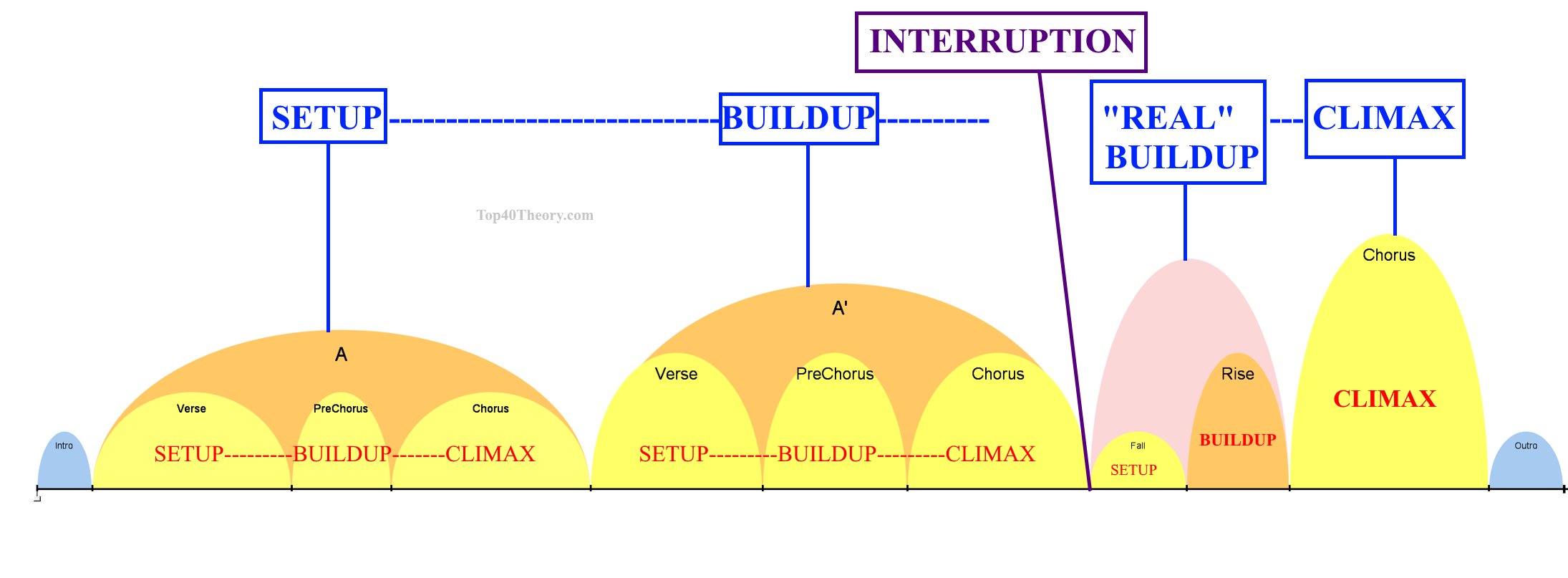
...but I'll explain this last one in more detail in my future post about song structure.
Zooming In
Going in the other direction, song sections often have an internal progression that can also be mapped out using sonic functions.
Let's go back to Bebe Rexha's "I'm a Mess" and take a closer look at the prechorus (0:24-0:44):
I mentioned earlier the gestures starting 0:42 that amp up the tension toward the chorus, but there are more internal processes at work throughout the prechorus that make it such an effective transitional section.
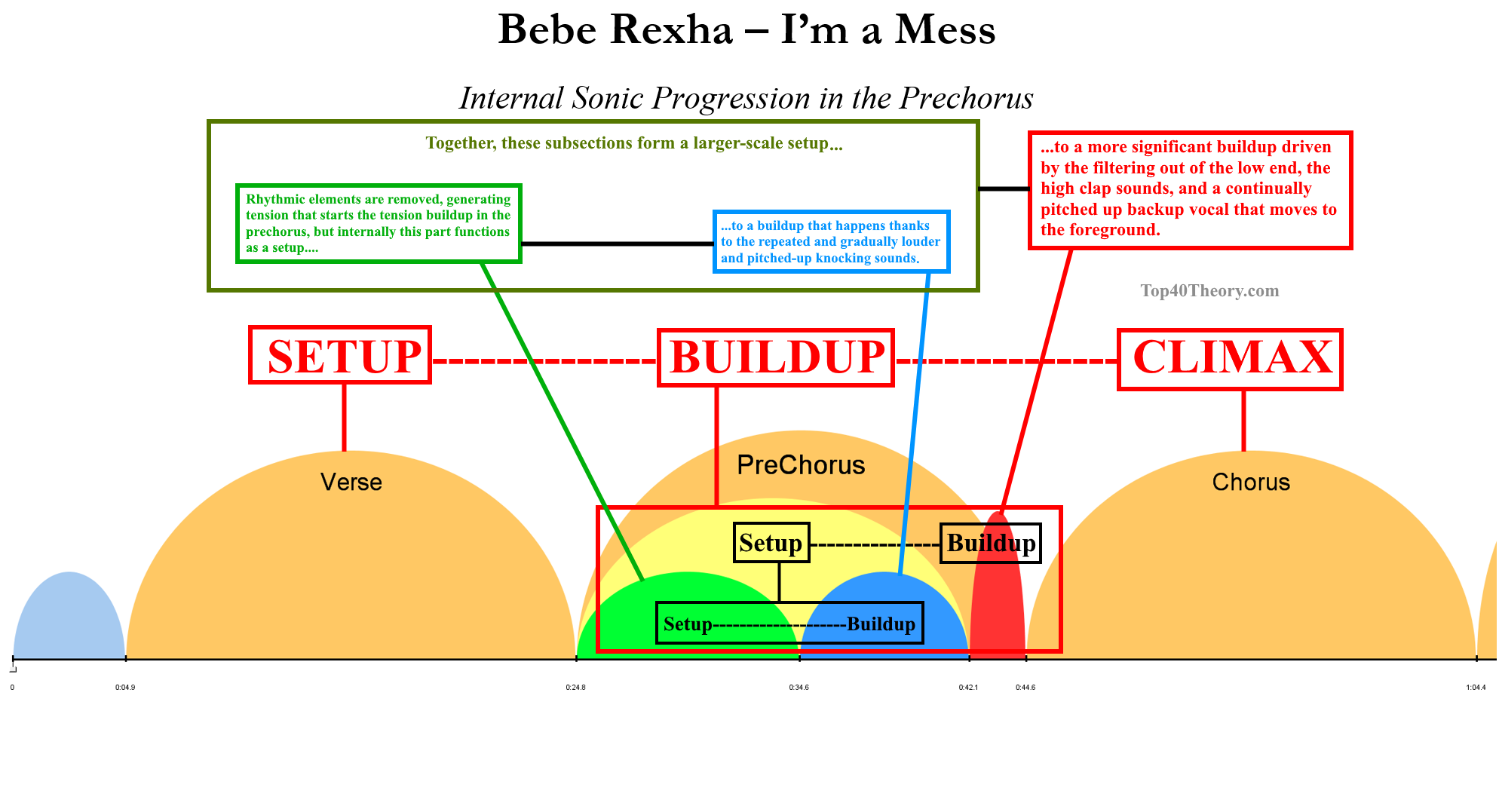
The prechorus starts by removing all the important rhythmic elements. At the section level, this already sounds like and functions as a buildup, but within the internal structure of the prechorus it is the setup for what comes next.
Halfway through the prechorus, a repeated knocking sound is introduced, which is gradually pitched up and made louder. This is now the internal buildup, which was set up by the earlier removal of the rhythmic elements.
However, this is not the buildup that actually leads to the climax. It's the sequence between 0:42-0:44 (the filtering out of the low end; the high claps; and the pitched up vocal) that finally amps up the tension to the degree that makes the arrival at the chorus so satisfying.
Within the internal structure of the prechorus, everything that came before this sequence was the setup to it.
The graph above shows these processes and how much depth there is to the sonic structure. I even left out the noise sweep at 0:33 that would divide the first half of the prechorus and add another structural layer.
The more you explore internal processes, the greater your intuitive understanding will be of the level of detail required to make great songs effective.
A BRIEF HISTORY OF SONIC FUNCTIONS
Sound production didn't take over the tension/release role in pop songs overnight. Over the last couple of decades, there has been a 'crossfade' between tonal functions and sonic functions.
As sound production became more and more dominant in shaping the musical roller coaster in pop songs, the role of tonal functions was gradually weakened.
I can't identify a specific turning point, but I can point to specific songs and albums that triggered my awareness of this process, such as Britney Spears's albums, Blackout (2007) and Femme Fatale (2011), as well as the aforementioned Rihanna and Calvin Harris song, "We Found Love" (2011).
The one thing I can say for certain, though, is that EDM's takeover of pop has a LOT to do with the acceleration of this process, and that's mostly from the current decade.
Some of the 'symptoms' of the weakening of tonal functions in pop music include:
- Avoiding harmonic cadences.
- Avoiding tendency tones.
- Avoiding chromaticism.
- Avoiding harmonic and melodic minor alterations.
- Creating ambiguity between relative major and minor keys.
- Avoiding ending chord progressions/loops on the tonic triad (I/i).
- Frequently starting chord progressions/loops on chords other than the tonic triad, and at times even omitting it entirely.
- Avoiding a direct V-I sequence anywhere in the chord progression.
- Sticking to the pentatonic scale in the vocal melody (thus avoiding the two most unstable tones in major and minor keys).
- Removing or altering ^7 when chords that contain it (such as V or iii) are involved.
Did Sonic Functions Exist Prior to Modern Pop?
The short answer? Yes. They were just far less dominant than tonal functions, but you can find them in any music, including in Bach and Beethoven.
But there are several differences:
- Bach and Beethoven's music was written on staff paper, which means they had the most control over parameters such as pitch and rhythm, and less over timbre, intensity, etc.
- The "final product" in classical music is traditionally the score (though it doesn't have to be). There are significant differences in the sound from one performance to the other.
- Bach and Beethoven didn't have access to a DAW, which gives the producer surgical control of the sound that they couldn't even dream about.
It wouldn't be a terrible idea, however, to try to analyze classical pieces, or music of any genre, for that matter, from the perspective of sonic functions.
Composers routinely included gestures that can be analyzed in those terms, such as changes in the instrumental texture and range, or gestures such as crescendo/diminuendo.
Moreover, great performers focus on sonic gestures as an important tool for musical interpretation, so analyzing different performances of the same piece through the lens of sonic functions also has potential for generating insight.
In any case, I am not trying to paint a picture of absolutes. Sonic functions have always been around to a certain degree, but were not typically a focal point for analysis because of the factors I mentioned above.
And tonal functions haven't completely disappeared from pop. Some songs still use them to varying degrees, although in most cases the functional relationships are contained in the chord loops and there is rarely large-scale tonal progression.
SONIC FUNCTIONS AND THE SONG STRUCTURE
One of the coolest things, in my opinion, about the rise of sonic functions is that they created a "production dimension" that is separate from and parallel to the "songwriting dimension".
Sometimes, the two dimensions correlate perfectly, like they do in the example I mentioned earlier - Demi Lovato's "Sorry Not Sorry":
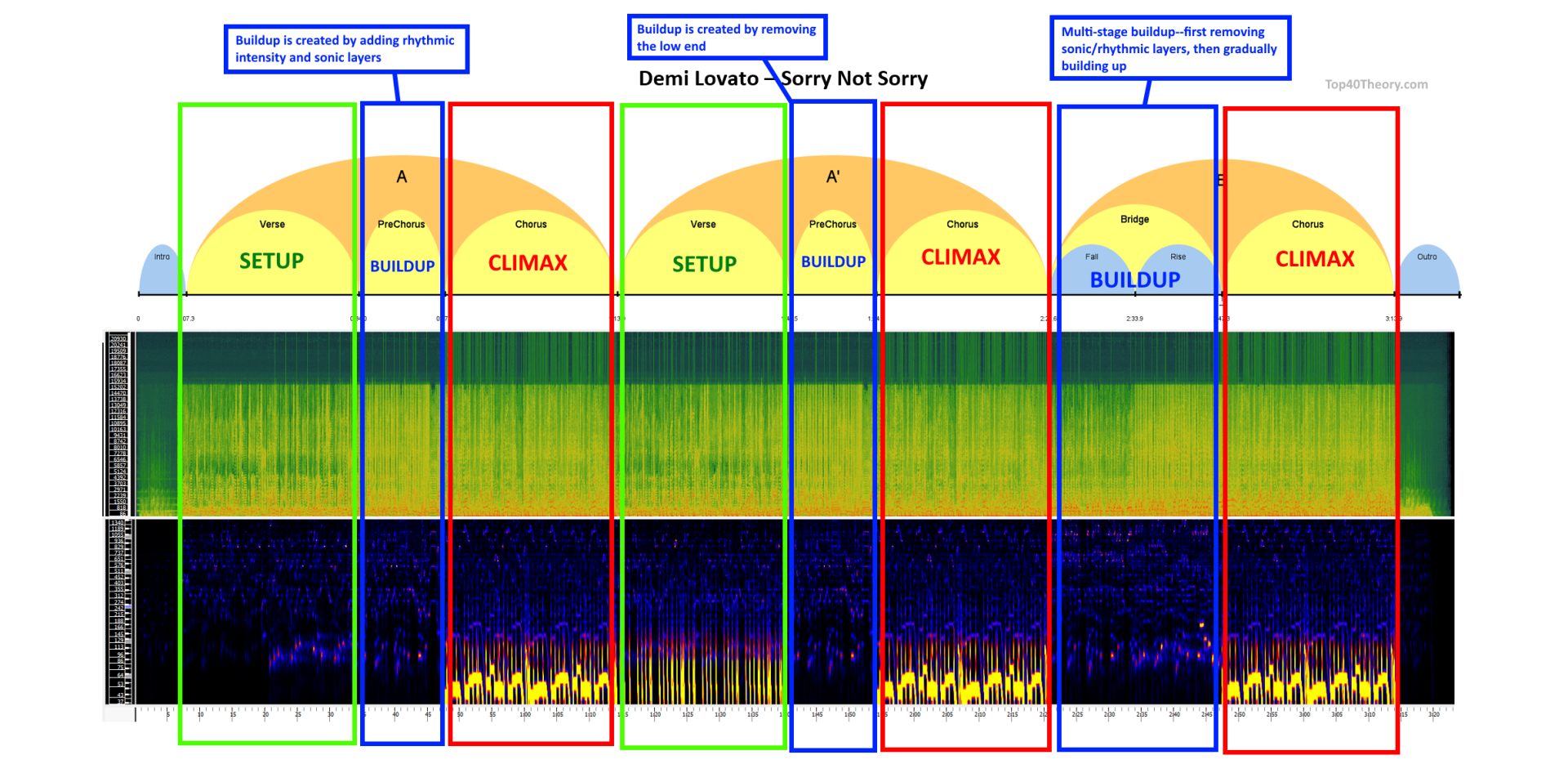
In "Sorry Not Sorry", the verse is the setup, the prechorus is the buildup, and the chorus is the climax.
But more and more the two dimensions diverge, which creates super interesting tension and super satisfying release.
The most common example of this is the pop-drop, a term coined by Charlie Harding and which I wrote about in my recent post about the postchorus.
In a typical pop-drop, the chorus, which is traditionally the song's climax, is transformed into a buildup, and the climax is delayed until the postchorus.
Here's an example from a recently released song - Zedd and Elley Duhé's "Happy Now":
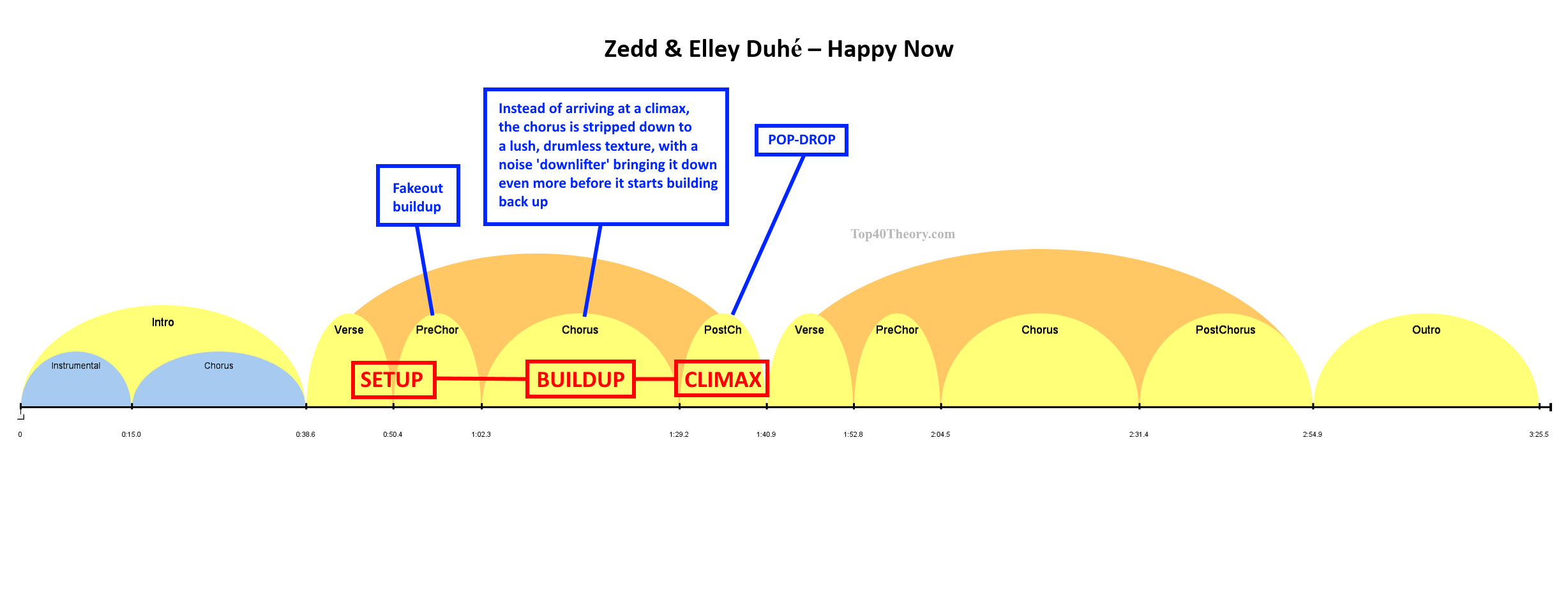
The prechorus intensifies compared to the verse, creating an anticipation for arrival at a climax, but it's a fakeout and it turns out the REAL buildup is in the chorus.
The texture in the chorus is first stripped down and later starts building up by: 1. Re-introducing the drums 2. Adding a noise sweep 3. Removing both the drums and the noise sweep AGAIN 4. Reverse vocal reverb into the pop-drop.
Let's look at this buildup in the chorus a bit more closely:

Pretty eventful for 27 seconds, I think...
Other Forms of Dimension Divergence
Of course, there are other ways in which the songwriting and production dimensions can diverge from one another. This is another topic I will explore in more detail in my post about song structure, but one prevalent way in which this happens is the postchorus-bridge switcheroo, which I wrote about a few months ago.
There are also songs that flip the relationship between the two dimensions on its head, like Machine Gun Kelly and Camila Cabello's "Bad Things", in which the chorus starts off as the sonic setup and the verses intensify. At the end of the song, however, the chorus returns to its conventional role and finally acts as a climax.
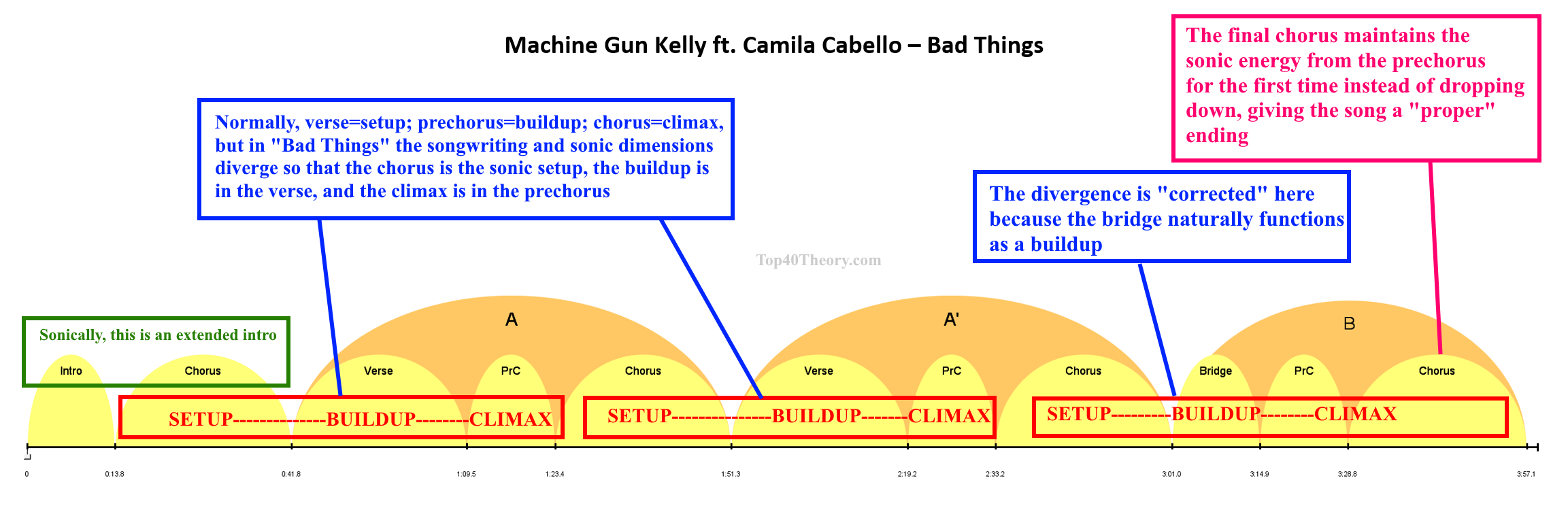
CONCLUSION
To summarize, for those who quickly scrolled through the last 3,500, these are my main points regarding sonic functions:
- Sonic functions emerged in large part as a result of the technological boom and the increasing prevalence of DAWs.
- They gradually replaced tonal functions as the musical backbone in pop music as EDM became more and more influential in the genre.
- The three main sonic functions are SETUP, BUILDUP, and CLIMAX, though they are not the only possible ones.
- Like tonal functions, sonic functions operate on multiple structural levels.
- The emergence of sonic functions created a "production dimension" in pop songs, that works in parallel to the "songwriting dimension". Sometimes these dimensions align, but they often diverge, creating more interest and tension.
If you are a producer, or even if you are strictly a songwriter who collaborates with producers, analyzing songs with a focus on sonic functions, structural levels, and the relationship between the two dimensions can be extremely beneficial. It has the potential to give you a new perspective and enhance your ability to plan the large-scale sonic arc of the song, as well as to help you understand the importance and function of the smallest details that make up great songs.
Top40 Theory Email List
Submit your email to receive important announcements about new courses and content from Top40 Theory
Thank you!
Copyright © 2022

